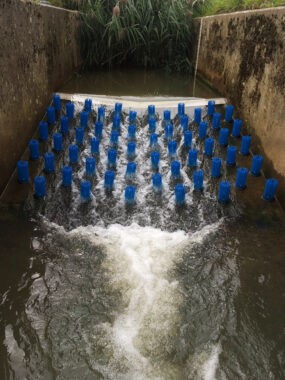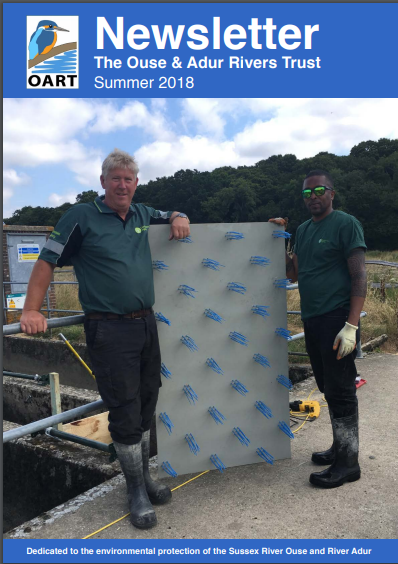 Daniella Montali-Ashworth commenced her CDT-SIS studentship project by adapting a theoretical concept related to fluid dynamics interactions with aquatic plants to better understand fluid mechanics associated with a cylindrical cluster of bristles. From the desk, she moved into the laboratory to test her assumptions, before moving into a highly interdisciplinary realm to explore how fish behaved when encountering these bristle clusters. Daniella observed that the clusters reduced drag and fish were able to use these to improve their passage through areas that were fast flowing and difficult to pass. The potential to use this low-cost technology to improve fish passage at human-made infrastructure, such as at weirs, that are known to block the migration of many endangered species was immediately obvious and Daniella shared her findings with the Environment Agency. The Environment Agency were particularly interested because they have a responsibility to improve the aquatic environment, and are faced with a contradictory pressure of installing and maintaining gauging weirs as part of their flood monitoring network, while at the same time removing infrastructure that is shown to negatively impact aquatic ecology by fragmenting habitat and blocking migrations. The Environment Agency agreed to fund additional elements of the project, which included a further series of experiments to quantify the hydrodynamic response to different bristle cluster spacings and how this influenced fish passage at model weirs.
Daniella Montali-Ashworth commenced her CDT-SIS studentship project by adapting a theoretical concept related to fluid dynamics interactions with aquatic plants to better understand fluid mechanics associated with a cylindrical cluster of bristles. From the desk, she moved into the laboratory to test her assumptions, before moving into a highly interdisciplinary realm to explore how fish behaved when encountering these bristle clusters. Daniella observed that the clusters reduced drag and fish were able to use these to improve their passage through areas that were fast flowing and difficult to pass. The potential to use this low-cost technology to improve fish passage at human-made infrastructure, such as at weirs, that are known to block the migration of many endangered species was immediately obvious and Daniella shared her findings with the Environment Agency. The Environment Agency were particularly interested because they have a responsibility to improve the aquatic environment, and are faced with a contradictory pressure of installing and maintaining gauging weirs as part of their flood monitoring network, while at the same time removing infrastructure that is shown to negatively impact aquatic ecology by fragmenting habitat and blocking migrations. The Environment Agency agreed to fund additional elements of the project, which included a further series of experiments to quantify the hydrodynamic response to different bristle cluster spacings and how this influenced fish passage at model weirs.
After several experiments conducted in the ecohydraulics flumes at the University of Southampton (www.icer.soton.ac.uk), Daniella worked in collaboration with the Environment Agency to test the efficacy of a prototype Cylindrical Bristle Cluster fish pass in the field. Cutting edge telemetry techniques were used to demonstrate that the technology improved fish passage at a weir that previously posed as complete barrier to the movement of some species. Based on these findings, the Environment Agency promoted the new novel and low-cost fish pass as the environmental impact mitigation technology of choice for low-head weirs. This is especially the case for gauging weirs because the Cylindrical Bristle Cluster fish pass has been demonstrated to enhance passability for fish by reducing drag without impacting weir function.
By the time Daniella successfully defended her thesis, the fish pass had already been installed at multiple sites in the South of England and the Isle of Wight. Since then the number of sites at which the fish pass has provided a positive solution to reconnect fragmented river habitat have increased, while Daniella spent a period working for the hydrometry group at the Environment Agency before being employed by an environmental consultancy that specialises in River Restoration.

Statement of impact provided by the Environment Agency:
The UK National hydrometry Network comprises over 1500 gauging weirs. The Environment Agency faces the conflicting challenge of maintaining flow monitoring capability while improving ecological status of rivers degraded by this infrastructure which disrupts fluvial connectivity. In 2018, the Environment Agency adopted the Cylindrical Bristle Cluster fish pass developed by the University of Southampton as best practice for a low-cost mitigation option for gauging weirs and their preferred “technology of choice” when ameliorating the impact of gauging weirs on fish movement. Since 2018, the low-cost design has been installed by several conservation groups, including the Ouse and Adur Rivers Trust, who have fitted the fish pass on multiple weirs to open up several kilometres of previously inaccessible river. Dr Peri Karageorgopolous from the Environment Agency said that, “It is simple to design and quick to fit. As a result the cost per site can be as little as £5K. The alternative solution which requires a bypass of the structure can easily cost £200K-£0.5M. As a result we are not only making tremendous savings but we are also planning to install many more bristle passes than we could ever deliver as bypasses…… the University of Southampton have created a novel, cost effective and efficient fish pass which will help improve fish populations worldwide”.
Reference:
Montali-Ashworth, D., Vowles, A., De Almeida, G., and Kemp, P. (2020). Use of cylindrical bristle clusters as a novel multispecies fish pass to facilitate upstream movement at gauging weirs. Ecological Engineering 143, DOI: 10.1016/j.ecoleng.2019.105634



